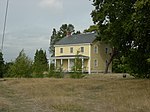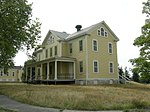
In the Historic District, looking toward Puget Sound. The visible buildings are, left to right, the Band Barracks, Guard House and Quartermasters Stables.
Fort Lawton was a United States Army post located in the Magnolia neighborhood of Seattle, Washington overlooking Puget Sound. In 1973 a large majority of the property, 534 acres of Fort Lawton, was given to the city of Seattle and dedicated as Discovery Park (Seattle). Both the Fort and the nearby residential neighborhood of Lawton Wood are named after Maj. Gen. Henry Ware Lawton.
While Fort Lawton was a quiet outpost prior to World War II, it became the second largest port of embarkation of soldiers and materials to the Pacific Theater during the war. The fort was included in the 2005 Base Realignment and Closure list. Fort Lawton officially closed on September 14, 2011.
History[]
In 1896, the Secretary of War selected what would later be Fort Lawton for construction of an artillery battery intended to defend Seattle and the south Puget Sound from naval attack. Local citizens and governments donated 703 acres (2.84 km2) land to the United States Army for the installation the next year.
Fort Lawton was named after Maj. Gen. Henry Ware Lawton (1843–1899), a veteran of the American Civil War, the Indian Wars, and Spanish-American War campaigns, who was killed in action in the Philippines. The fort opened on February 9, 1900[1] on a 1,100 acres (4.5 km2) site, which was redesigned in 1902 for infantry use. In 1910, a design overhaul, to include housing for officers and enlisted men, was prepared by landscape architect John C. Olmsted. In 1938 during the Great Depression, the Army offered to sell Fort Lawton back to the city of Seattle for one dollar, but the city declined, citing maintenance concerns.
During World War II, at least 20,000 troops at a time were stationed at Fort Lawton, with more than 1 million troops passing through both before and after the war. It was the second-largest port of embarkation for US forces and material to the Pacific Theater during the war.
The post was also used as a prisoner-of-war camp, with more than 1,000 Germans imprisoned there. Approximately 5,000 Italians were passed through en route to Hawaii for imprisonment. On August 15, 1944 an Italian POW, Guglielmo Olivotto, was found murdered at Fort Lawton after a night of rioting between Italian POWs and American soldiers. Twenty-eight African-American soldiers were later court-martialed, convicted of the crime, and sent to prison. They and their families challenged the convictions; after an investigation, the convictions were set aside in 2007. A formal army apology ceremony was held on July 26, 2008; officials also presented the relatives of former US soldiers and the two remaining survivors with years of back pay, following the overturn of their dishonorable discharges.[2][3]
On Memorial Day 1951, a grove of trees and monument honoring the war dead was dedicated near the post chapel. The Korean War brought a flurry of activity as troops headed to or returned from Korea were processed through Fort Lawton. In February 1953, the Fort Lawton Processing Center transferred half of its functions, the outbound tasks, to Fort Lewis (now called Joint Base Lewis McChord). Returnees continued to process through Fort Lawton.
- see also: Fort Lawton Air Force Station
In the late 1950s, Nike anti-aircraft missiles and Air Force radars were in use at Fort Lawton, but in 1968 the site was rejected for proposed defense upgrades. The Army surplussed 534 acres (2.16 km2) in 1971. The property was transferred back to the city in 1972, and dedicated as Discovery Park in 1973.[4]
In 2005, the fort was included in the Base Realignment and Closure list for that year. Fort Lawton's family housing has been used by the U.S. Navy for Navy and Coast Guard personnel for almost 40 years. It is currently being vacated, with the officer and NCO housing scheduled to be sold to the public when the market improves. The Capehart Housing in the center of the park was vacated by December 2009 and demolished during the summer of 2010; the land has become part of Discovery Park.
Fort Lawton officially closed on September 14, 2011, and the 364th Expeditionary Sustainment Command, the last U.S. Army Reserve tenant on the post, moved to its new facility in Marysville, Washington. A closing ceremony took place on February 25, 2012.[5] The remainder of the fort property (with the exception of the military cemetery on site) was due for transfer to the City of Seattle sometime in 2012.
The future of the last fort property has been contentious, as local residents, city leaders, and local homeless advocates have battled over its proposed use.
Historic district[]
The Fort Lawton Historic District (FLHD) in the heart of Discovery Park contains numerous historic buildings and structures that were once in, and part of, Fort Lawton. The following list includes only buildings and structures that survived at least into the 1980s.
Source for buildings, construction dates, comments:[6]
The Chapel[]
The chapel, which is outside the Historic District, has the status of a city landmark.[7]
References[]
- Fort Lawton Landmark District, Department of Neighborhoods (City of Seattle)
- Heather MacIntosh, Preservation at Fort Lawton and Discovery Park, Preservation Seattle (Historic Seattle), January 2004.
- Yardley, William (October 26, 2007). "1944 Conviction of Black G.I.’s Is Ruled Flawed" (Newspaper article). New York Times. http://www.nytimes.com/2007/10/27/us/27punish.html?hp. Retrieved 2007-10-28.
Notes[]
- ↑ Wilma, David (October 17, 1999). "Fort Lawton is established on February 9, 1900". Essay 1757. HistoryLink.org. http://www.historylink.org/essays/output.cfm?file_id=1757. Retrieved 2010-04-02.
- ↑ , "http://www.cnn.com/2008/CRIME/07/27/soldiers.apology.ap/index.html?eref=rss_topstories"
- ↑ Yardley, "1944 Conviction of Black G.I.’s Is Ruled Flawed"
- ↑ Duane Colt Denfeld, "Fort Lawton to Discovery Park", HistoryLink.org Essay 8772, 23 September 2008. Accessed 2 April 2010.
- ↑ Gutierrez, Scott (24 Feb 2012). "Historic Fort Lawton will officially close during weekend ceremony" (Newspaper article). Seattle Post-Intelligencer. http://www.seattlepi.com/local/article/Historic-Fort-Lawton-3356965.php. Retrieved 2012-02-25.
- ↑ Steve Wilke and Karen James, An Archeological Evaluation of the Fort Lawton Historical District, Seattle, Geo-Recon International (Seattle), July 1984. A report submitted to the City of Seattle Department of Parks and Recreation. p 43–47.
- ↑ Landmarks Alphabetical Listing for F, Individual Landmarks, Department of Neighborhoods, City of Seattle. Accessed 28 December 2007.
External links[]
| Wikimedia Commons has media related to Fort Lawton. |
- Impromptu query for historical sites in Magnolia, Department of Neighborhoods (City of Seattle). Most of the listings are Fort Lawton buildings.
- Fort Lawton Cemetery listing at Find A Grave
- U.S. Geological Survey Geographic Names Information System: Fort Lawton
- U.S. Geological Survey Geographic Names Information System: Fort Lawton Military Cemetery
Archives[]
- Seattle Chamber of Commerce Army Post Committee. 1896-1897. 1 volume. Contains records about the fundraising campaign ran by the Army Post Committee to raise funds for the purchase of land for Fort Lawton. At the Labor Archives of Washington, University of Washington Libraries Special Collection.
Coordinates: 47°39′40″N 122°24′53″W / 47.66104°N 122.414792°W
The original article can be found at Fort Lawton and the edit history here.










